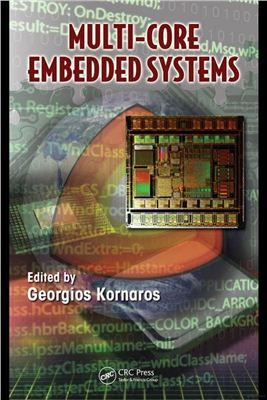CRC Press, 2010. — 492 p., 205 b/w Ill. — ISBN-10: 143981161X,
ISBN-13: 9781439811610.
Книга начинается с обзора развития многопроцессорных архитектур для
встраиваемых приложений и обсуждаются методы для автономного
управления питанием на уровне системы параметров. В ней
рассматриваются использование инструментов с открытым исходным
кодом, происходящих из нескольких доменов, приложений, таких как
трафик моделирования, теории графов, параллельные вычисления и
моделирования сети.
Кроме того, авторы охватывать другие важные темы, связанные с многоядерных встроенных систем, таких как:
архитектуры соединений;
встроенные методологии дизайна;
отображение приложений;
программирование парадигмы и модели вычислений;
оптимизации энергопотребления и вопросы надежности;
производительность инструментов и критериев;
управление ресурсами;
многопоточность;
многоядерные проблемы программирования;
компиляция и поддержка операционных систем. Increasingly demanding mode applications—such as those used in telecommunications networking and real-time processing of audio, video, and multimedia streams—require multiple processors to achieve computational performance at the rate of a few giga-operations per second. This necessity for speed and manageable power consumption makes it likely that the next generation of embedded processing systems will include hundreds of cores, while being increasingly programmable, blending processors and configurable hardware in a power-efficient manner. Multi-Core Embedded Systems presents a variety of perspectives that elucidate the technical challenges associated with such increased integration of homogeneous (processors) and heterogeneous multiple cores. It offers an analysis that industry engineers and professionals will need to understand the physical details of both software and hardware in embedded architectures, as well as their limitations and potential for future growth.
Кроме того, авторы охватывать другие важные темы, связанные с многоядерных встроенных систем, таких как:
архитектуры соединений;
встроенные методологии дизайна;
отображение приложений;
программирование парадигмы и модели вычислений;
оптимизации энергопотребления и вопросы надежности;
производительность инструментов и критериев;
управление ресурсами;
многопоточность;
многоядерные проблемы программирования;
компиляция и поддержка операционных систем. Increasingly demanding mode applications—such as those used in telecommunications networking and real-time processing of audio, video, and multimedia streams—require multiple processors to achieve computational performance at the rate of a few giga-operations per second. This necessity for speed and manageable power consumption makes it likely that the next generation of embedded processing systems will include hundreds of cores, while being increasingly programmable, blending processors and configurable hardware in a power-efficient manner. Multi-Core Embedded Systems presents a variety of perspectives that elucidate the technical challenges associated with such increased integration of homogeneous (processors) and heterogeneous multiple cores. It offers an analysis that industry engineers and professionals will need to understand the physical details of both software and hardware in embedded architectures, as well as their limitations and potential for future growth.

